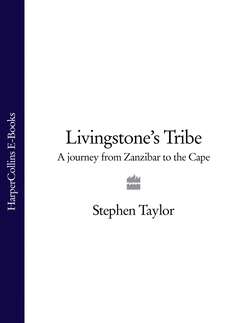Читать книгу Livingstone’s Tribe: A Journey From Zanzibar to the Cape - Stephen Taylor - Страница 12
5. The Enclave
ОглавлениеLake Hotel, Bukoba: Friday, 21 March
ANOTHER LAKE HOTEL, ANOTHER decrepit old colonial hangout, but here dilapidation is on the grand scale. I arrived at about seven yesterday morning, having trudged a mile or so from the port, and at first thought the place had been abandoned. Everything was shut, panes of glass were missing from doors and windows and of guests or staff there was no sign at all. I unslung the rucksack, sat down on the verandah and dozed off. After an hour a man in his underpants appeared on the lawn with a toothbrush and set about his toilet at the tap.
The hotel lies at what must have been the social hub in colonial days. It looks out towards that glittering lake across what was the Gymkhana Club, now a blackened concrete shell with a fading Pepsi sign painted on the side, and the golf course. Walking this afternoon among the scrub and sand dunes, I could find no trace of the course save for what appears to have been an elevated green set between palm trees; around it are indentations that might once have been bunkers. Off to one side is the remains of the telegraph tower which kept the local German garrison in touch with Berlin and which was destroyed in 1915 during one of the few British successes in the East Africa campaign. In an overgrown glade near the hotel lies a small European cemetery, but its occupants predate the war: there are a few Italians and a Portuguese or two as well as German soldiers like Wilhelm Muller, a sergeant who died here in 1909 at the age of twenty-three.
I got back from my walk yesterday evening to find the verandah crowded and a party going on in the tiny bar. This used to be the men’s snug and there are still touches of an English pub, like the fox hunting print over the fireplace. There was nothing complacent about the drinking, however. I fell in with a languid fellow who was doing fearful damage to the only bottle of Scotch on the shelves. It turned out that he was a pilot from Uganda. I was alarmed to hear the drone of his aircraft taking off on a run to Dar early this morning.
Tanzania must have Africa’s noisiest birdlife. In Kigoma it was crows, chorusing in a state of constant outrage. Here the hadeda ibis sets up a clamour well before dawn. It has a harsh bray astonishingly penetrating for so small a creature, but which fades away into an unearthly and heart-rending cry, like a woman or a child sobbing inconsolably. A strange animal. It made me think of the family and the months of separation ahead, and for a while I felt deeply lonely. I took out the photographs but looking at them caused an almost physical pain, and I quickly put them away.
Then there was a bang on the door and a cry of ‘Welcome’. When I went out there was a steaming pail of hot water.
The only decoration in the breakfast room is a notice with the worst bit of doggerel I can recall:
Always remember to forget the things that made you sad,But never forget to remember the things that made you glad.
The food is almost bad enough to make me sad. Tilapia, which I remember as a delicious fish, seems unobtainable. Nile perch can sometimes be had but is coarse and muddy. Neither goat nor beef, much in evidence in the countryside, ever seems to turn up on a plate. I never want to see chicken and rice again. As ever, though, the service is gracious.
BUKOBA EPITOMISED ALL that was worst in colonialism. Not worst in a brutal, Maxim-gun way, nor even perhaps the sneering, contemptuous sense, but as it reflected the ignorance and greed that gripped the European powers during the later stages of the ‘Scramble’, when Africa was carved up with set squares and compasses without thought to the viability, let alone the ethnic composition, of the territories being created. Far more damaging than the physical abuse suffered by Africans at the hands of the odd individual sadist was the system which created the borders of modern Africa. Bukoba is a case in point.
The people here are the Haya, descendants of the kingdoms which evolved west and north of Lake Victoria and which so impressed European travellers with the state of their development. Buganda was the most powerful of these kingdoms when Speke arrived in 1862, but others had flourished at other times – Ankole, Toro, Bunyoro and Karagwe, the kingdom of the Haya. For long it was believed that the kingdoms had been founded by a superior race of pastoral folk from the Ethiopian highlands, probably of Nilotic origin. More recent evidence suggested that they were western Bantu, having emanated from one of the greatest and most successful of all migratory movements, which started in the Niger – Congo region around the time of Christ. By the fourteenth century a series of petty states had developed into prosperous monarchies familiar with pomp and ritual. The kings ruled through sub-chiefs but their authority was total and unquestioned. Although they frequently warred with one another over cattle, they were isolated from the holocaust of slavery going on around them and flourished in a sort of regional cocoon. The Haya, although militarily weak, were able agriculturalists and produced a fine robusta coffee. Their king, Rumanika, was a vast, amiable man with a fondness for fat wives; members of his harem were force-fed until they resembled young hippopotamuses. One woman measured by Speke had a bust of 52 inches and a thigh of 31 inches.
